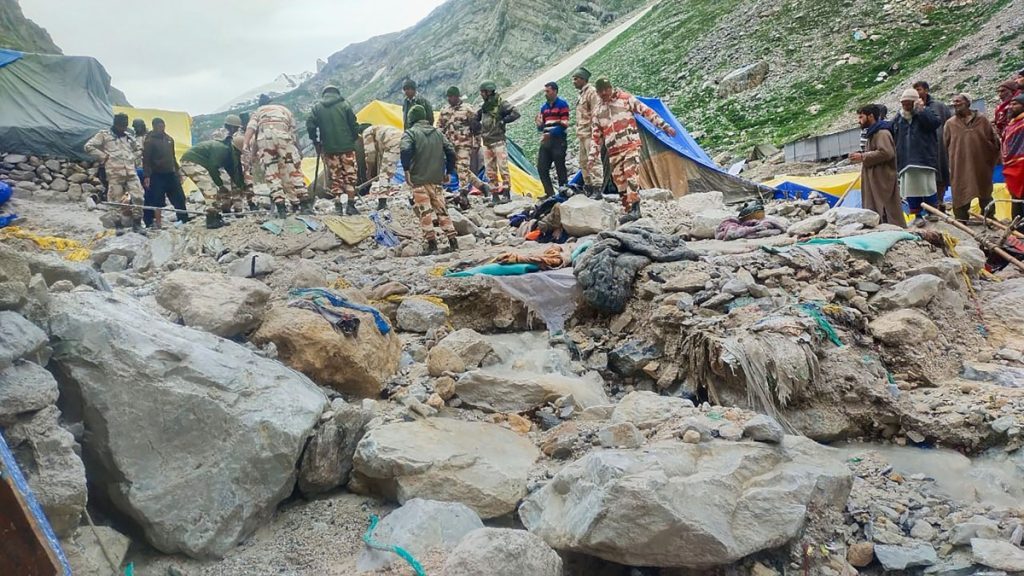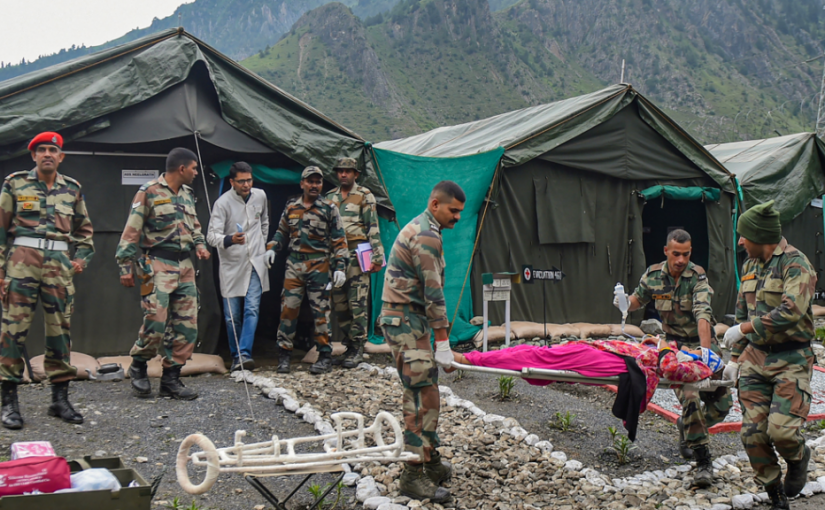Baltal: Army soldiers carry an injured pilgrim evacuated from cloudburst areas near the Amarnath cave shrine by a helicopter, at Baltal in Ganderbal district, Saturday, July 9, 2022. At least 15 people, mainly Amarnath pilgrims, have died and dozens went missing after flash floods caused landslips near the shrine.
By Pamela Philipose
Parallel to the allegations against the Muslims in Assam, the godi media is also claiming Pakistan for the tragedy enroute to the sacred Amarnath shrine. The Amaranth shrine is a natural formation of ice into a shivling which happens during the extreme winter in Jammu & Kashmir. The shrine is located in the Anantanag district and pilgrims have to pass through a narrow road to get to the shrine risking landslides and flash floods.
It has been nine days since the Amarnath Yatra tragedy and we still don’t have a grip on the death count. All we have are some indeterminate numbers – over 16 dead, over 40 missing and over 60 injured. It is only a matter of time when the last two numbers slowly trickle in and swell the first as the immensity of the loss of people with actual faces and loved ones slowly sinks in.
We also don’t have a precise idea of what actually happened at that spot in the Lidder Valley en route to the venerated cave. It was 5:30 pm on July 8. The evening weather forecast for all routes to the shrine said that there would be partly cloudy skies with chances of light rain. That was it.
So what was this bolt from the heavens all about?
Most reports claimed that it was a “cloud burst” that did the damage (a cloud burst is said to occur when 100 mm of rain falls in an hour). Knowledgeable others say that it was a “flash flood”. The fact remains that there is much about this tragedy that has defied easy categorisation.
As Sonam Lotus, director of the meteorological department, Jammu and Kashmir, observed in a media interaction: “We suspect that the region above the Amarnath cave may have experienced a cloudburst, leading to highly intense and highly localised rainfall that our automatic weather station could not catch. We have no means of measuring the rainfall there as it is a very remote area.”
In other words, there will always be unpredictability about the weather during the Amarnath Yatra that takes place in those rare weeks mid-year when the mists overhanging this region lift. The impact of extreme human footfall on an incredibly fragile terrain that is already ravaged by climate change make weather assessments even more complex.
One of the abiding memories that a journalist I spoke to who had covered the Amarnath Yatra in 1996, when freak blizzards led to the deaths of an estimated 260 yatris, was the chaos and overcrowding that had marked it. He pointed out that the inquiry committee headed by retired bureaucrat Nitish Sengupta had only underlined this.
The Kailash Mansarovar Yatra is a good example of how such pilgrimages could be conducted with its specifications on the number of persons permitted as well as their minimum and maximum ages. There is monitoring of their fitness levels, besides health checks, as well as the institutionalisation of proper acclimatisation procedures before the climb. This could explain why the authorities handling this yatra seem to have been far more successful in preventing large-scale tragedies despite the fact that it is longer and more arduous. But coming to the media question, why was the story of this tragedy rendered cold within a few days of its occurrence?

This suggests that there were innumerable vested interests working to kill it prematurely. Within three days of the catastrophe, we were being fed media images of “happy yatris” clapping and cheering the resumption of the trek. There were very few first-person reports of what actually happened.
A rare one appeared in the Times of India, which incidentally was among the few newspapers that also carried an editorial on the subject. It decried “the obsession with setting footfall records” and pointed out that while the Nitish Sengupta committee had suggested a ceiling of 3,000 travellers in any of the sectors in a single day, this time if the plans hold it would mean 18,605 a day.
Generally speaking, the media made only feeble attempts to hold those behind the arrangements accountable, although there was the occasional report that tried to break through the silence. The Indian Express reported that tents set up in the same dry river bed last year had been washed away by a cloudburst.
But since that yatra had been cancelled because of the pandemic there had been no casualties. So why were tents pitched up at the very same spot this year? Was it to accommodate the ever-burgeoning numbers of pilgrims? No answers from the authorities so far. One of the lobbies anxious to pump up the numbers of yatris and airbrush the tragedy out of the frame is the tourism sector. As the divisional commission for Kashmir explained to The Wire, the Amarnath Yatra is “not just a pilgrimage, but also a significant economic boost for Jammu and Kashmir as the government anticipates revenue of between Rs 2,000 and Rs 3,000 crore” (‘Srinagar Shopkeepers Claim Livelihoods Hurt Due to Amarnath Yatra Security, Police Deny Charge’, July 4).
And it is not just J&K. Tourist companies across India stand to benefit enormously. They offer trips for every pocket, ranging from the basic version in the region of Rs 12,500 per person to fancier options that could be ten times as much. In fact, the one sector in India that continues to be inflation-proof is the pilgrimage sector.
The other pressure group that is anxious to put the memory of the July 8 developments behind it is the Shri Amarnathji Shrine Board (SASB), chaired by Manoj Sinha, the Lieutenant Governor of J&K, which as its website maintains is responsible for the “better management of the Shri Amarnathji Yatra, upgradation of facilities for holy pilgrims and matters connected therewith or incidental thereto.” Interestingly, on securing the safety of the pilgrim, there is nothing stated.
Instead of insisting on accountability, the media displayed a very obvious desire to move on, leaving the dead to count their own. This was also possibly driven by a perception that yatras of this kind are being envisioned by the Modi government as a major electoral outreach.
It’s a variation of the old bread and cakes axiom: if they don’t have jobs, if the economy is going south, if the rupee is gasping, at least allow them their pilgrimages. How else can it be explained that despite serious objections from environmentalists, the government continues to be fixated on its Char Dham highway widening intervention that will eventually connect the shrines at Gangotri, Yamunotri, Kedarnath and Badrinath at a cost of Rs 12,000 crore.
Major forest loss will result from this project with hundreds of thousands of trees fated to go under the axe. An analysis in the science and environmental magazine, Down to Earth, points out that the “Ruthless harvesting or uprooting of vegetation in the widening of roads can prove to be perilous for the biodiversity and regional ecology. The stability of river slopes, it points out, is crucially dependent on the vegetal cover. The media are sleepwalking through this real and present danger and even something like the recent calamity on the slopes surrounding the Amarnath cave has not proved to be a wake-up call.
Mind your language, MP!
After stopping journalists, even those with valid parliamentary accreditation, from accessing Parliament, this government has now come up with a list of “unparliamentary” words which Members of Parliament must not take recourse to.
Read the list and you will understand why the opposition is up in arms – words that have been routinely deployed to convey the state of the country and the incompetence of the government in power have now been proscribed.
Some of them have even emerged from the mouths of those in the ruling party. After all, it was Union home minister Amit Shah who popularised the term “jumla”. Now ‘jumlajeevi’ can no longer be pronounced on the floors of both Houses.
Words vital to make a point about current repression such as ‘taanashahi’, or current politics betrayal such as ‘Jaichand’, or current fraudulent behaviour, such as ‘corrupt’ are in the list of verbal no-no’s. Some are important descriptors like ‘Khalistani’, while others are as common as the air we breathe – such as ‘drama’ or ‘ashamed’.
Courtesy: The Wire
